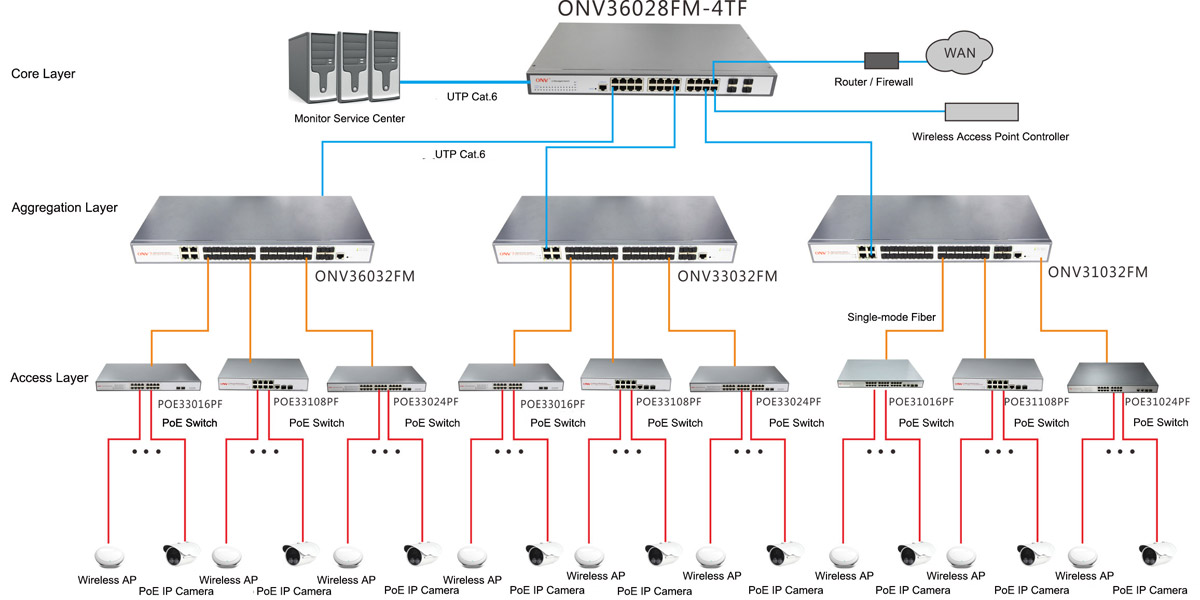With the wide use of HD IP cameras, it is very important to choose an appropriate switch that meets the whole network structure of a monitoring system. An appropriate switch not only can enable the function of the monitoring network system, but also effectively reduce the waste of resources.
PoE Switch Important Parameter
Switching Capacity
Switch capacity is the max data capacity of the switch interface processor or the max data capacity between the interface card and data bus. It shows the switch ability for total data exchanging, and its unit is Gbps, also called switching capacity. The switching capacity value of the switch is higher, and the processability of data is higher. switching capacity calculation method: switching capacity =port numbers*port speed*2
Switching capacity ≤Nominal switching capacity, then the switch is wire-speed, also called non-blocking.
Forwarding Performance (Sum of all port forwarding rates)
Forwarding Rate, also known as port throughput. It refers to the data packet forwarding ability of a port in the switch, the unit is pps (packet per second). In general, the forwarding rate for a low-end router is from a few K to a few ten Kpps, while for a high-end router, the value could reach ten Mpps (Million Packets per Second), even hundreds of Mpps.

Forwarding rate calculation method: Forwarding rate = full configuration gigabit port numbers*1.488Mpps+Full configuration 10/100M port numbers*0.1488Mpps.
Forwarding rate ≤ Nominal forwarding rate, the switch is wire-speed, or called non-blocking.
PoE Switch Selection Tip
The switch configuration of a large and medium-scale network monitoring system consists of three parts: the access layer, the aggregation layer, and the core layer.

Access Layer
The actual Switch Capacity of switch is 50% - 50% of the theoretical value, so the actual Switch Capacity for 10/100M port is around 50 to 70M.
As 4M*12 = 48M for example, it is recommended that 100M switches be connected to max 12 pcs of 720P network camera.
At the same time, considering the dynamic coding way of current network monitoring, the stream peak value of the camera may be more than 4M. Considering the Switch Capacity redundancy design, the recommended access quantity of 100M switch is within 8pcs, if more than that, it is recommended to connect with a gigabit port.
Aggregation Layer
The performance of the switch in the aggregation layer is higher than the requirement of the access switch, and clients can choose the L2 switches with thousands of upload ports as the aggregation switch.
The 10/100M port of the aggregation switch is connected to the access switch and the gigabit port is connected to the core switch. The number of cameras on the aggregation switch should be controlled at about 30.
720P network camera with 4M as an example, there are 6 pcs of 720P network camera in each switch in the access layer, and the aggregation switch is connected with 5 pcs of the above access switch. The total bandwidth of the aggregation layer switch is 4M*6*5 = 120M, therefore the aggregation switch should be connected with the core switch through a gigabit port.
Core Layer
The core switch is an important part of the digital monitoring system, it is the connecting bridge of the aggregation switch, monitoring platform storage server, etc. It is suggested to choose L3 full gigabit core switches. If the quantity of connected cameras is more than 150 units, a L3 10G core switch is recommended.
Example
We usually use 8-port switch if there are 5 IP cameras to be connected. To test if the 8-port switch meets the requirement, we need to consider below three aspects
1. Switch Capacity = Port numbers*Port speed*2. Namely 8*100*2= 1.6Gbps/S
2. Forwarding Rate =Port numbers*Port Speed/1000*1.488Mpps. Namely 8*100/1000*1.488Mpps=1.2Mpps/S. If the forwarding rate is less than that, the switch type is non-line speed. It is easy to cause delays if there are large capacity data under receive and send.
3. Bandwidth of uplink port = IP Camera Stream * Numbers. Namely 4.5*5=22.5Mbps/S. It is recommended to use 1000M uplink port when the bandwidth of the IP camera is over 45Mbps.
Inclusion for choosing the switch
Flow control function.
For easy management, Web management switch is recommended.
Due to the video flow being larger, the line-speed switch is recommended.
If there are emergent properties in video data, a larger cache switch is better.
It is suggested to choose a well-known brand aggregation switch and core switch.